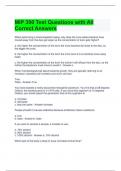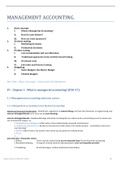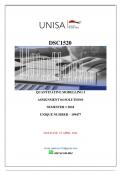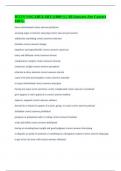Book summary
Content
Chapter 6 - Income Taxes……………………………………..…………………….2
Chapter 7 - Financial Instruments…………………………………………………..16
Chapter 14 - Business Combinations……………………………………………….42
Chapter 16 - Financial Statement Presentation……………………………………53
Chapter 20 - Consolidation: Controlled Entities………………………………...….68
Chapter 21 - Consolidation: Wholly Owned Subsidiaries…………………….…...77
Chapter 23 - Consolidation: Non-Controlling Interest……………………………...84
Chapter 24 - Foreign Currencies………………………………………………….….89
Chapter C - Associates and Joint Ventures……………………………….………...98
Chapter D - Joint Arrangements………………………………………………….....106
1
,Chapter 6
Income taxes - IAS 12
According to paragraph 1 of IAS 12, the standard applies in accounting for income taxes,
including all domestic and foreign taxes based on taxable profits.
- It also applies to withholding taxes that are payable by a subsidiary, associate or joint
arrangement on distributions to a reporting entity.
- The standard does not deal with methods of accounting for government grants or
investment tax credits, but it does deal with accounting for tax effects arising in
respect of such transactions.
Accounting profit: ‘profit or loss for a period before deducting tax expense’
→ Excess/Deficiency of income less expenses for that period
Taxable profit: ‘profit for a period, determined in accordance with the rules established by
the taxation authorities, upon which income taxes are payable’
→ Excess of taxable income over taxation deductions allowable against that income
Because both profits are determined by different principles and rules, they are unlikely to be
the same. Instead, accounting for income taxes involves identifying and accounting for the
differences between accounting profit and taxable profit. These differences arise from a
number of common transactions and may be either permanent or temporary in nature.
Permanent differences
These arise when the treatment of a transaction by taxation legislation and accounting
standards is such that amounts recognised as part of accounting profit are never recognised
as part of taxable profit, or vice versa.
- Examples of permanent differences include income never subject to taxation such as
dividend income, and expenditure incurred by an entity that will never be an
allowable deduction such as entertainment expenditure.
- Where such differences exist, taxable profit will never equal accounting profit. No
accounting requirements other than disclosure exist for these permanent differences.
Temporary differences
Temporary differences between accounting profit and taxable profit arise when the period in
which revenues and expenses are recognised for accounting purposes is different from the
period in which such revenues and expenses are treated as taxable income and allowable
deductions for tax purposes.
- For example, interest revenue recognised on an accrual basis, may not be taxable
income until it is received as cash.
- The key feature of these differences is that they are temporary, because sooner or
later the amount of interest revenue will equal the amount of taxable interest income.
- However, in any one individual accounting/taxation period, these amounts will differ
when calculating accounting profit and taxable profit respectively
2
, ● Differences that result in the entity paying more tax in the future (e.g. when interest is
recognised for accounting purposes in a period before it is received and included in
taxable income) are known as taxable temporary differences.
● Differences that result in the entity recovering tax via additional deductible expenses
in the future (e.g. when accrued expenses are recognised for accounting purposes in
a period before they are paid and included as a tax deduction) are known as
deductible temporary differences.
Appendix A to IAS 12 gives examples of temporary differences arising from different
treatments of transactions for accounting and taxation purposes, some of which are listed
below.
Taxable temporary differences Deductible temporary differences
Interest revenue is received in arrears and is Retirement benefit costs are deducted in determining
included in accounting profit on a time- accounting profit because service is provided by the
apportionment basis but is included in taxable employee, but are not deducted in determining taxable
profit on a cash basis. profit until the entity pays either retirement benefits or
contributions to a fund. Similar temporary differences arise
in relation to other accrued expenses — such as product
warranties, leave entitlements and interest — which are
deductible on a cash basis in determining taxable profit.
Revenue from the sale of goods is included in Accumulated depreciation of an asset in the financial
accounting profit when goods are delivered but statements is greater than the cumulative depreciation
is included in taxable profit only when cash is allowed up to the end of the reporting period for tax
collected. purposes. That is, the accounting depreciation rate is
greater than the allowable taxation depreciation rate.
Depreciation of an asset is accelerated for tax The cost of inventories sold before the end of the reporting
purposes (the taxation depreciation rate is period is deducted in determining accounting profit when
greater than the accounting rate). goods or services are delivered, but is deducted in
determining taxable profit only when cash is collected.
Development costs are capitalised and The net realisable value of an item of inventory, or the
amortised to the statement of profit or loss and recoverable amount of an item of property, plant and
other comprehensive income but are deducted equipment, is less than the previous carrying amount. The
in determining taxable profit in the period in entity therefore reduces the carrying amount of the asset,
which they are incurred. but that reduction is ignored for tax purposes until the
asset is sold.
Prepaid expenses have already been deducted Research costs (or organisation or other start-up costs)
on a cash basis in determining the taxable profit are recognised as an expense in determining accounting
of the current or previous periods. profit, but are not permitted as a deduction in determining
taxable profit until a later period.
Depreciation of an asset is not deductible for tax Income is deferred in the statement of financial position
purposes and no deduction will be available for but has already been included in taxable profit in current or
tax purposes when the asset is sold or prior periods (for example, subscriptions received in
scrapped. advance).
3











